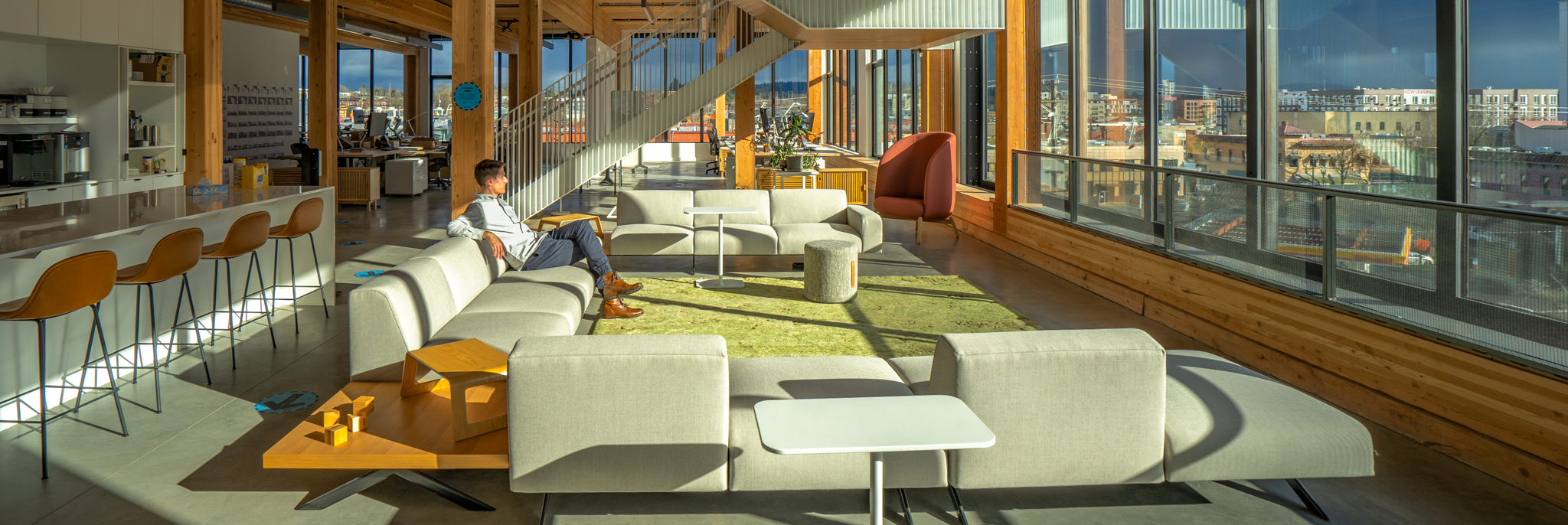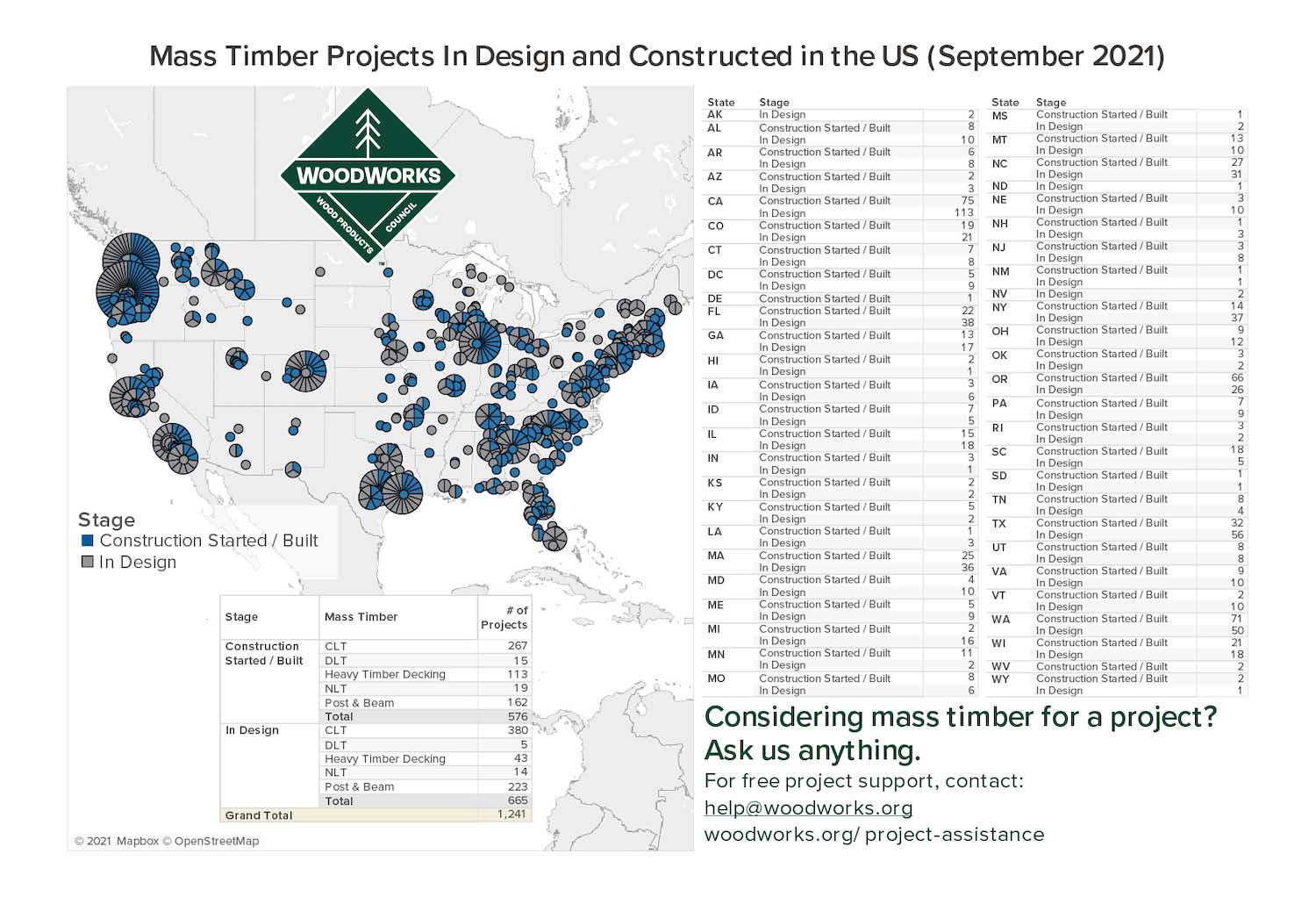
Home
Mass Timber Rising
Sustainable Forests
Tall Wood – Low Carbon
Fuels to Frame
About
What is Mass Timber
Making Cities Part of the Solution
Tall Wood is Hot – Here’s Why
In the last few years, mass timber construction has emerged as one of the hottest construction trends in the U.S., and it’s only growing in popularity. According to North American Mass Timber1, from 2016 to 2019, the square footage of mass timber projects quadrupled in the U.S. Data from Woodworks shows that as of March 2021, the U.S. had 541 projects in construction and another 600 in design, which is twice the amount of the prior year. In addition to the number of new projects, mass timber has also been tapped as the building material of choice for some of the globe’s leading companies including Microsoft, Adidas, Google, and Walmart.
Source: https://www.woodworks.org/wp-content/uploads/WoodWorks-Mass-Timber-Projects-Q3-2021.jpg
Given the long history of green building and wood products manufacturing in the Northwest, it’s not surprising that the region is a leader in the mass timber movement. With over 100 projects either built or in construction, and more than 60 in design, the mass timber construction community in the Northwest has evolved, building world-class expertise and experience.
Portland is also home to the International Mass Timber Conference whose growth reflects the rise of the mass timber industry. The first year of the event brought together over 500 people from a dozen countries. By 2021, the conference saw over 1,800 attendees and participation from 39 countries. This year’s event is expected to draw over 2,000 attendees from several dozen countries.
So, what’s driving the rise of mass timber construction in the Northwest? Its appeal integrates ecology and technology. Ecologically, wood is a natural, renewable material that brings warmth and beauty into the built environment. Technologically, mass timber construction uses an advanced prefabricated product that increases the speed of construction and lowers labor costs. Mass timber competes on both looks and price.
The Bottom Line
From the perspective of a developer, a building has got to pencil out. In many cities, developers and designers are starting to see that mass timber construction can improve a building’s bottom line through quicker lease up rates and lower vacancies. Given that mass timber buildings are approaching cost parity with traditional construction methods, this can make mass timber buildings more competitive.
“A lot of our clients are now starting to understand that mass timber leads to quicker leasing and fewer vacancies. We are proving that we can build these buildings for the same cost as other structural systems,” said Corey Martin, Architect at Hacker Architects.
Cost Effective
Mass timber construction can be described as a “kit of parts” designed and fabricated off-site and packaged in the order of installation. A truck arrives at the job site loaded with mass timber panels. Workers attach the panels to a crane and they are hoisted into place and installed in a matter of minutes. As the wood has already been machined to tight tolerances by computer controlled equipment, cutting and trimming at the job site is minimized. These attributes speed up the construction process and reduce some of the noise and traffic impacts during construction, which the neighbors undoubtedly appreciate.
“Mass timber buildings are really an assembly of a kit of parts and that speeds up construction. We have buildings that fully cover the mass timber but using it speeds up the build time,” noted Ethan Martin, of DCI Engineers.
Code Approved
Building codes are intended to ensure the health and safety of a building’s occupants. Codes are, by their nature, slow to change. Code changes are the product of significant technical review, testing, and evaluation at many levels. When the International Code Council (ICC) approved code changes to the 2021 edition of the International Building Code and the International Fire Code allowing for a prescriptive pathway for mass timber buildings up to 18 stories, it was as if mass timber came of age. But, each state has to adopt the code on their own.
Currently, four states have adopted the 2021 IBC code changes, allowing for mass timber construction up to 18 stories: Oregon, Washington, California and Utah. California adopted the new ICC codes in July of 2021. The City of Denver, Colorado also adopted the new ICC codes.
Prior to the new codes being approved in the US, developers wishing to build with mass timber above six stories had to get special approval from the building codes department. Without prescriptive codes, the approval process relies on performance-based design, which is generally thought to raise cost, increase time, and add real or perceived risk. As more states adopt the prescriptive codes for tall mass timber construction, the pace of adoption will pick up.
Connection to Nature/Biophilia
As cities grow and more people live and work in urban areas, people’s connections to nature can be difficult to maintain. Mass timber appeals, in part, because it brings the warmth and natural qualities of wood into the built environment. Dubbed “biophilic design,” the approach seeks to connect building occupants more closely to nature by incorporating natural lighting, ventilation, and natural materials (like plants and wood).
Intuitively, this design approach makes sense. Scientists are now quantifying that intuition. According to ThinkWood, “an Australian research firm surveyed 1,000 Australian workers and found a correlation between the presence of wood and employees’ overall satisfaction at work, lower absenteeism, higher levels of concentration, and improved productivity.”
The Northwest has a long history of building with wood and architects are excited about the unique possibilities of incorporating more wood into their buildings.
“Wood is this amazing material that comes from nearby that provides such a great opportunity to introduce warmth and beauty and tactile qualities and connection to nature into all aspects of our buildings whether it’s the exterior or the interior cladding or a ceiling. For me personally, it goes beyond that, it goes into the level of art,” noted Corey Martin, Hacker Architects.
Sustainability and Carbon Storage
“Carbon is a big issue for architects. Where does the wood come from and are the forests sustainably managed?” noted Judith Sheine, Co-Director of the TallWood Design Institute and University of Oregon’s School of Design.
Carbon is a big issue for architects and for all of us. The built environment accounts for approximately 40 percent of greenhouse gas emissions and wood products from sustainably managed forests are an increasingly important part of a climate solution. Because wood stores carbon and contains less embodied carbon than concrete and steel, companies seeking to build more sustainably are choosing to build with wood.
Just how important is the use of wood in sustainability? When Paul Schwer, President of PAE Consulting Engineers in Portland decided that their new corporate headquarters in Portland, Oregon would meet the lofty goals of the Living Building Challenge (generally considered to be the zenith of sustainable building design) they chose to build with wood.
“One of the biggest moves we could make on embodied carbon was to switch from a steel and concrete building essentially to a mass timber building,” said Paul Schwer, President of PAE consulting engineers.
The appeal of mass timber comes from its unique combination of low-carbon material and biophilic design while still competing on price and speed of construction.
1 Anderson, Atkins, Beck, Dawson and Gale (2020). North American Mass Timber 2020: State of the Industry. Forest Business Network.
Previous
Next
What is Mass Timber
Making Cities Part of the Solution

